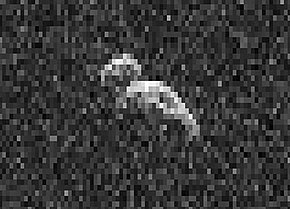 Radar image of 2006 DP14 by the Arecibo Observatory in 2014 | |
| Discovery[1] | |
|---|---|
| Discovered by | LINEAR |
| Discovery site | Lincoln Lab's ETS |
| Discovery date | 23 February 2006 |
| Designations | |
| (388188) 2006 DP14 | |
| 2006 DP14 | |
| Apollo · NEO · PHA[2][1] | |
| Orbital characteristics[2] | |
| Epoch 23 March 2018 (JD 2458200.5) | |
| Uncertainty parameter 0 | |
| Observation arc | 10.10 yr (3,690 d) |
| Aphelion | 2.4262 AU |
| Perihelion | 0.3056 AU |
| 1.3659 AU | |
| Eccentricity | 0.7763 |
| 1.60 yr (583 d) | |
| 234.28° | |
| 0° 37m 2.64s / day | |
| Inclination | 11.778° |
| 317.20° | |
| 59.280° | |
| Earth MOID | 0.0163 AU (6.35 LD) |
| Physical characteristics | |
| Dimensions | 400 m × 200 m[3] |
| 0.4 km[3] 0.493 km (calculated)[4] | |
| 5.77±0.01 h[5][a] 5.78±0.02 h[6] 6 h[3] | |
| 0.20 (assumed)[4] | |
| S (assumed)[4] B–V = 0.670±0.022[6] V–R = 0.400±0.015[6] V–I = 0.792±0.031[6] | |
| 18.80±0.02[6] 18.9[2][4] | |
(388188) 2006 DP14, provisional designation 2006 DP14, is a sub-kilometer sized, peanut-shaped asteroid on a highly eccentric orbit, classified as near-Earth object and potentially hazardous asteroid of the Apollo group. This contact binary was discovered on 23 February 2006, by astronomers of the LINEAR program at the Lincoln Laboratory's Experimental Test Site near Socorro, New Mexico, in the United States.[1] On 10 February 2014, it passed 6.25 lunar distances from Earth.[2][3] The asteroid is approximately 400 meters in diameter and has a rotation period of 5.77 hours.[4][a]
- ^ a b c Cite error: The named reference
MPC-objectwas invoked but never defined (see the help page). - ^ a b c d Cite error: The named reference
jpldatawas invoked but never defined (see the help page). - ^ a b c d Cite error: The named reference
Radar-Goldstonewas invoked but never defined (see the help page). - ^ a b c d e Cite error: The named reference
lcdbwas invoked but never defined (see the help page). - ^ Cite error: The named reference
Warner-2014iwas invoked but never defined (see the help page). - ^ a b c d e Cite error: The named reference
Hicks-2014bwas invoked but never defined (see the help page).
Cite error: There are <ref group=lower-alpha> tags or {{efn}} templates on this page, but the references will not show without a {{reflist|group=lower-alpha}} template or {{notelist}} template (see the help page).